Horn
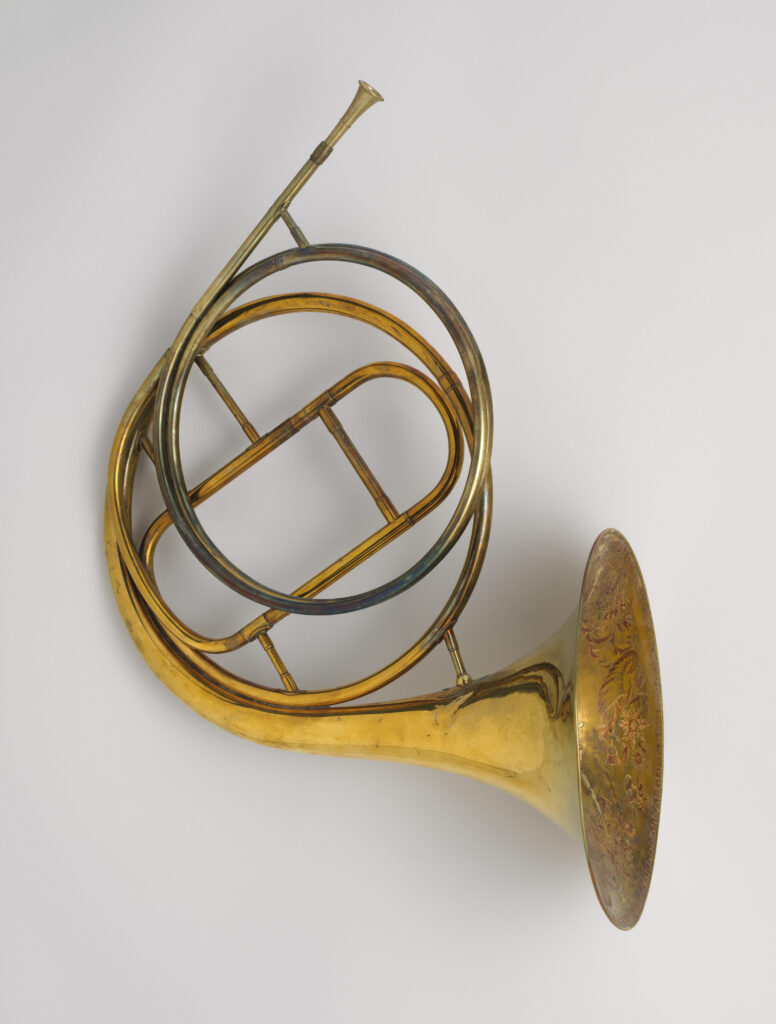
The Horn (latterly known as French Horn or Cor de Chasse) has a rich and colourful history, dating from the 16th century in its earliest guise as a hunting horn.
In 18th century London, the horn was heard as a solo, chamber, and orchestral instrument in all varieties of musical establishments; from pleasure gardens, such as Vauxhall, to West End theatres, and concert rooms. It was also featured in military bands in the British Army, including the Coldstream Guards.[1]Picture Credit – Purchase, The Howard Bayne Fund Gift, 1977. The Metropolitan Museum of Art
In 1753, German musician Anton Joseph Hampel (1710-1771) invented movable slides (crooks) of various length which changed the key of the horn. In the 19th Century, valves where invented, and through the century they slowly replaced the crook system, leading to the development of the modern French Horn.
Having been designed as an outdoor instrument, the horn was perfect for Pleasure Gardens. It was featured on the stage in concertos, symphonies, and songs, as well as more informally; A small band of horns could be hired to play during supper after the concert at Vauxhall Pleasure Gardens, and tea could be taken at Islington Spa to their accompaniment. Bands of horns and clarinets also performed at Marylebone Pleasure Gardens, and at Finch’s Grotto Gardens.[2]Sadie, Stanley. “The Wind Music of J. C. Bach.” Music & Letters, vol. 37, no. 2, Oxford University Press, 1956, pp. 107–17, http://www.jstor.org/stable/728946. p.2
London’s Premiere Horn Players in the 18th & 19th Centuries
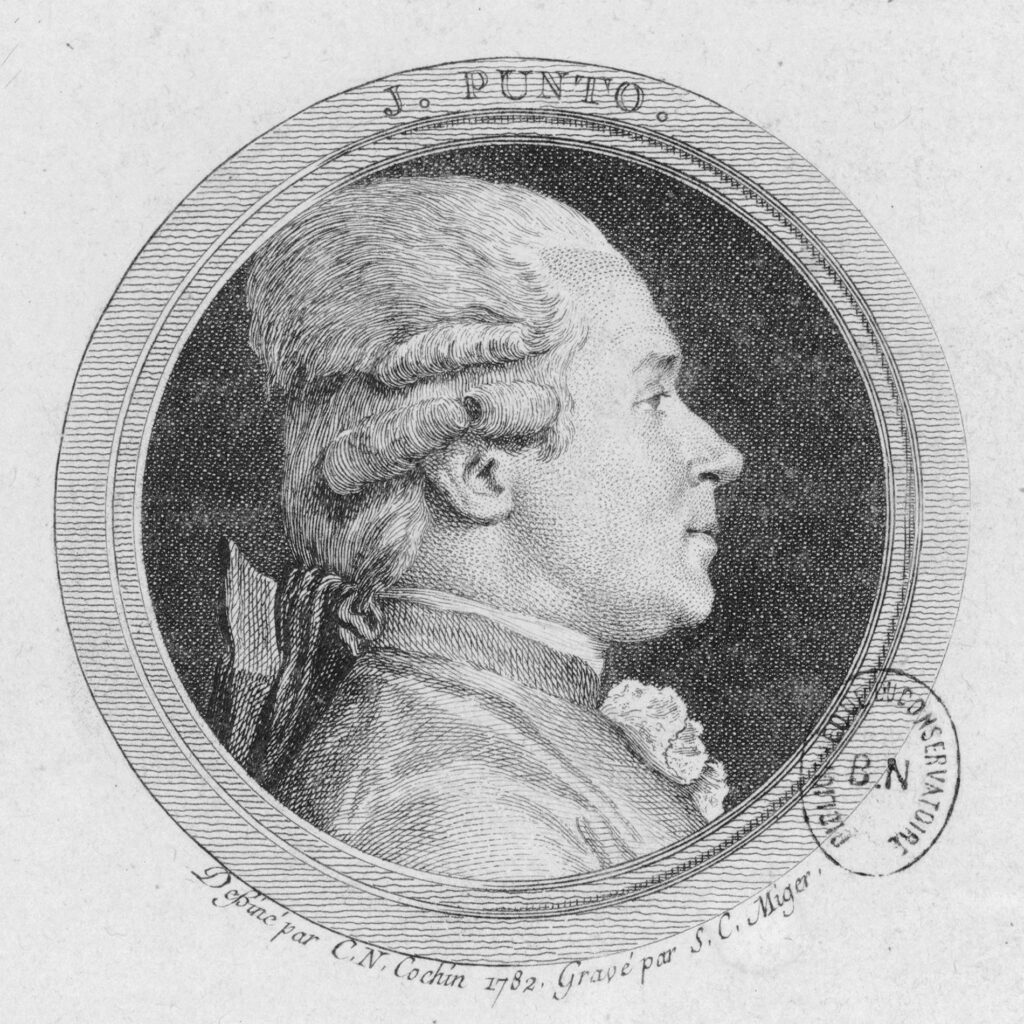
Giovanni Punto (1746-1803)[3]Picture Credit: Giovanni Punto by Simon-Charles Miger, Public domain, via Wikimedia Commons
Punto visited London in 1772, performing a concerto on the French horn at the King’s Theatre, and in the oratorio at Covent Garden Theatre. He also played in performances at the Drury Lane and Haymarket Theatres, and performed Milton’s Morning Hymn as a duet with the renowned oboist Johann Fischer.
Punto returned to London in 1788, performing at the Drury Lane Theatre, the Pantheon, and at the King’s Theatre, where he played a concerto at the end of Act IV of Paisiello’s comic opera La Frascatana, accompanied by the principal dancers.
His use of “stopping” the horn was criticised by the British press, probably due to the novelty, but he remained a very popular performer, and was invited by George III to tutor the horns in his private band.
Punto was born Jan Václav (or Johann Wenzel) Stich in Zehusice, near Cáslav, in what is now the Czech Republic. After a disagreement with his employer Count Josef Johann von Thun, which resulted in the threat of the loss of his front teeth, and subsequent end to his horn career, Stich fled to Italy and changed his name to Giovanni Punto. He was also known as “Ponta”, “Ponto”, and “Ponté”.[4]Highfill, Philip H., JR, Burnim, Kalman A., Langhans, Edward A. – A Biographical Dictionary of Actors, Actresses, Musicians, Dancers, Managers, & Other Stage Personnel in London 1660-1800. … Continue reading
Punto performed across Europe, and his fame was far-reaching. Leading theatre manager, composer, and tenor Michael Kelly, who became Punto’s close friend in London, spoke of “Monsieur Ponté, first French horn player to the King of Prussia, and a very fine performer“.[5]Kelly, Michael – Reminiscences of Michael Kelly, of the King’s Theatre, and Theatre Royal Drury Lane. 1826
While in Coblenz in 1772 Dr Charles Burney noted: “The elector has a good band, in which M. Ponta, the celebrated French horn from Bohemia, whose taste and astonishing execution were lately so much applauded in London, is a performer.“[6]Burney, Charles – The Present State of Music in Germany, the Netherlands, and United Provinces. Or, the Journal of a Tour Through Those Countries to Collect Materials for a General History of … Continue reading
In 1801 the critic of the Prague Neue Zeitung wrote that Punto “…showed unparalleled mastery of his difficult instrument, and his execution was such that the best connoisseurs had never heard its like. His phrasing was always essentially vocal both in the upper and lower registers. In rapid or slow cadenzas he would introduce double and even triple chords. plus variations contained musical effects that were entirely novel, and his playing enriches our fatherland with what has long been reported and is now proven, namely the tame of having given a great genius to music”[7]Highfill, Philip H., JR, Burnim, Kalman A., Langhans, Edward A. – A Biographical Dictionary of Actors, Actresses, Musicians, Dancers, Managers, & Other Stage Personnel in London 1660-1800. … Continue reading
In 1778 Mozart wrote the horn part in his Sinfonia Concertante for Four Winds in Eb Major for Punto, enthusing: “Punto bläst magnifique” (“Punto blows magnificently”), and Punto was the horn player for whom Beethoven wrote his Sonata for Horn and Piano Op.18.
Punto used a silver horn built in 1778 in Paris by Lucien-Joseph Raoux.
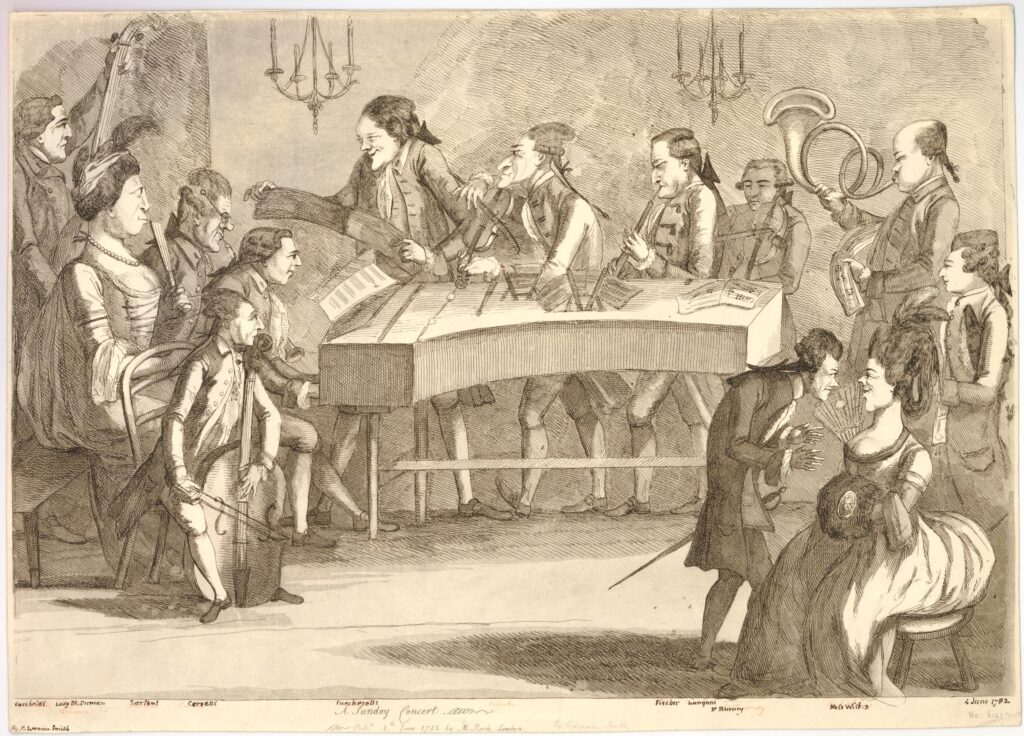
Pierre-Joseph Pieltain (b.1751)
Belgian horn player Pieltain joined the band of the Prince of Wales in 1786. In 1791 he was in the band at the Pantheon for the operas and ballets, and played at the Professional Concerts at the Hanover Square Rooms. Charles Burney listed Pieltain among the horns in the Handel Memorial Concerts at Westminster Abbey.[8]Doane’s Musical Directory – 1794
Brother of violinist Dieudonné Pascal Pieltain, Pierre-Joseph studied with the great Bohemian horn player Giovanni Punto, who also visited London.
Pieltain was depicted with other musicians (including Vauxhall Gardens oboist Johann Fischer, and Dr Charles Burney himself) in an engraving by James Bretherton (above).
He lived at No 43, Frith Street, Soho, London.

Charles Tully (1787-1845)
Performed as a horn soloist at Vauxhall Pleasure Gardens in 1824 and 1826.[9]http://www.vauxhallgardens.com/vauxhall_gardens_musicians_page.html
Tully played the horn in the Philharmonic Society Orchestra from its inception in 1813. He also performed at the Covent Garden Theatre, and the Theatre Royal, Haymarket.[10]Martz, Richard J – Reversed Chirality in Horns, or Is Left Right? The Horn, on the Other Hand.
His Tutor for the French Horn was published in 1840.
Tully played with his left hand in the bell of the horn.
Picture Credit.[11]Picture Credit – Horn by Pierre Piatet (French, ca. 1796–1868). Purchase, The Howard Bayne Fund Gift, 1977. The Metropolitan Museum.
Giovanni Puzzi (1792-1876)
An eminent soloist, chamber and orchestra member, Italian horn player Puzzi became the UK’s most celebrated horn player of the 19th century.
As a child prodigy in Italy, Puzzi had caught the attention of Napoleon, and was given a place in the Chapelle de l’Empereur. Following the fall of Napoleon in 1815, the Duke of Wellington invited Puzzi to live in London.
Firmly establishing himself as a leading player in London, Puzzi became Principal Horn of the Italian Opera at the King’s Theatre, performing alongside the renowned horn-playing Petrides brothers, Joseph and Peter.[12]Strauchen, E. Bradley – Giovanni Puzzi and Horn Playing in London’s Orchestras in the 1820’s. He was also a member of the Concerts of Ancient Music, and the Philharmonic Society. Puzzi acquired a notable reputation as a master of the chromatic late hand-horn technique, performing as soloist in his own arrangements with this technique.
Puzzi took up the post of Professor of Horn at the newly-formed Royal Academy of Music in London in 1823.
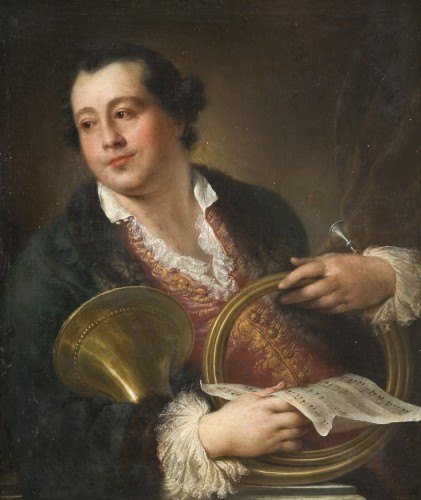
Jean Joseph Rodolphe (1730-1812)
French musician Rodolphe visited London in 1770.[13]Picture Credit – Louis-Gabriel Blanchet (1705-1772) portrayed Rodolphe with his horn in 1759. This painting is in a private collection, auctioned in 2010
He performed a horn solo at the King’s Theatre, and a concerto at the Covent Garden Theatre.
Rodolphe studied the horn with his father, Theodore Peter, before heading to Paris to study violin with Leclair. Choosing to devote himself to the horn, Rodolphe gained a position at the court chapel in Parma, Italy. His performances were very well received:
“Mr. Rudolph [sic] astounded the listeners with the harmonious and gentle tones that resounded from his French horn. The whole assembly remained in an indescribable ecstasy as long as he let himself be heard.“
Willem Spandau (1741-1806)
Dutch horn player and composer Spandau came to London in 1773 to perform at the King’s Theatre, Covent Garden Theatre, and the Haymarket Theatre. He also played a concerto for two horns with Giovanni Punto.
Charles Burney attended the London concerts, and was full of praise for Spandau’s technique, correct intonation and chromatic mastery of the range. Spandau played in the band of the Stadholder of the United Provinces in the Netherlands, and Burney had previously heard him performing in The Hague, noting that Spandau was the first to make artificial notes agreeable.[14]Herbert, Trevor; Wallace, John; Cross, Jonathan, Editors – The Cambridge Companion to Brass Instruments. Cambridge University Press, 1997. p.112
“I found Mr. Spandau, who has since been heard with so much pleasure in London, at The Hague. Through his diligence, taste, delicacy, and presentation, he managed to get his French horn, an instrument which, because of its roughness, could only be endured in the open air or in a large building, to be heard just as gently and pleasantly, as a human voice”.[15]Burney, Charles – The Present State of Music in Germany, the Netherlands and the United Provincesteenth-Century Musical Tour In Central Europe And The Netherlands Vol-II
Henry Charles Jarrett (1816-1888)
Jarrett performed on the horn at Vauxhall Pleasure Gardens in 1840, 1841, and 1845.[16]http://www.vauxhallgardens.com/vauxhall_gardens_musicians_page.html He also performed in Philharmonic Concerts, and at The Adelaide Gallery.[17]Barlow, Helen – Brass and woodwind players’ routes into the music profession

The Leander brothers: Lewis Henry (1769-1830) and Vincent Thomas (b.1770)
The London brothers were two of the most celebrated horn players in Europe. Performances include a concerto for two horns at the Haymarket Theatre (1784), and performances at the Covent Garden oratorios, Drury Lane Theatre. They also performed as part of Salomon’s concerts at the Hanover Square Rooms.[18]Highfill, Philip H., JR, Burnim, Kalman A., Langhans, Edward A. – A Biographical Dictionary of Actors, Actresses, Musicians, Dancers, Managers, & Other Stage Personnel in London 1660-1800. … Continue reading
The portrait shows a young man with a horn, c.1790.
Thomas Attwood, senior (1737-1813)
Father of Thomas Attwood junior, the composer who studied with W.A. Mozart, Attwood senior performed as a horn player in the Prince of Wales’ Band of Musicians[19]F. G. E. “Thomas Attwood. (1765-1838).” The Musical Times and Singing Class Circular, vol. 41, no. 694, Musical Times Publications Ltd., 1900, pp. 788–94, https://doi.org/10.2307/3368298., at Westminster Abbey, and with the Academy of Ancient Music.[20]Barlow, Helen – Brass and woodwind players’ routes into the music profession
Adam Rathgen (fl.1760-1780)
Rathgen performed on the horn, oboe, and clarinet at Marylebone Pleasure Gardens.[21]Barlow, Helen – Brass and woodwind players’ routes into the music profession
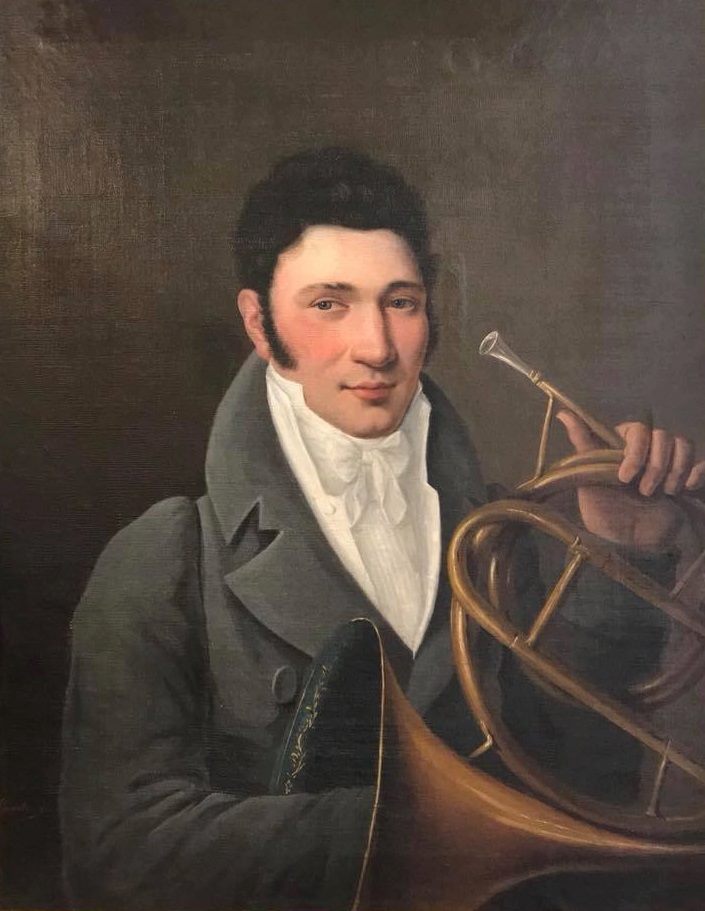
George Kellner (1784-1836)
Kellner performed in Queen Charlotte’s Band of Musicians.[22]Barlow, Helen – Brass and woodwind players’ routes into the music profession
Portrait of a horn player, c.1815 – Portrait d’un corniste, Jacques-François Gamelin (1774-1871)
Henry Platt (1795-1871)
Platt was 1st Horn in the Opera Concerts, the Philharmonic Society, and the Royal Academy Concerts. He was Professor of Horn at the Royal Academy of Music.[23]Barlow, Helen – Brass and woodwind players’ routes into the music profession
Daniel Frederick Price (1768-1813)
Price played the horn at the Covent Garden Theatre Oratorios in 1795 and 1796[24]Highfill, Philip H., JR, Burnim, Kalman A., Langhans, Edward A. – A Biographical Dictionary of Actors, Actresses, Musicians, Dancers, Managers, & Other Stage Personnel in London 1660-1800. … Continue reading, and Ranelagh Pleasure Gardens.[25]Barlow, Helen – Brass and Woodwind Players’ routes into the music profession
He lived at Duke’s Court, St Martin’s Lane, London.
Samuel Saunders (1759-1801)
Sadler’s Wells equilibrist and slack-wire artist Saunders was not an average horn player. In 1781 he balanced a drinking glass on his head with the wire in full swing, and with a French horn on his lips, sounded a minuet without using his hands, simultaneously performing a “continual Summerset on the Wire, while fireworks are playing from different parts of his body.”[26]Highfill, Philip H., JR, Burnim, Kalman A., Langhans, Edward A. – A Biographical Dictionary of Actors, Actresses, Musicians, Dancers, Managers, & Other Stage Personnel in London 1660-1800. … Continue reading
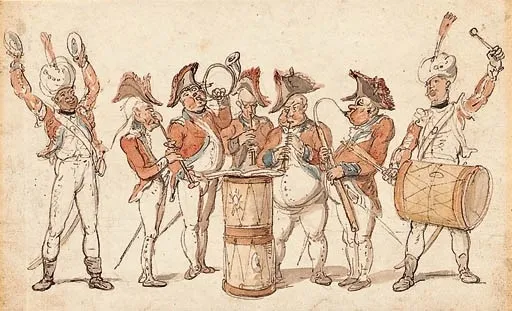
Bibliography & Credits
Researchers – Laura Piras and Adrian France
Contributor – Ursula Paludan Monberg
Burney, Charles – The Present State of Music in Germany, the Netherlands, and United Provinces. Or, the Journal of a Tour Through Those Countries to Collect Materials for a General History of Music. 1771.
Burney, Charles – The Present State of Music in Germany, the Netherlands and the United Provinces. 1773
Kelly, Michael – Reminiscences of Michael Kelly, of the King’s Theatre, and Theatre Royal Drury Lane. 1826
Highfill, Philip H., JR, Burnim, Kalman A., Langhans, Edward A. – A Biographical Dictionary of Actors, Actresses, Musicians, Dancers, Managers, & Other Stage Personnel in London 1660-1800. South Illinois University Press, 1975. Volumes: 9, 12 & 13
The Musical Times and Singing Class Circular, vol. 41, no. 694, Musical Times Publications Ltd., 1900, pp. 788–94. F. G. E. “Thomas Attwood. (1765-1838)”. Read the full article here
Barlow, Helen – Brass and woodwind players’ routes into the music profession. Read the full table here
Herbert, Trevor; Wallace, John; Cross, Jonathan, Editors – The Cambridge Companion to Brass Instruments. Cambridge University Press, 1997.
Martz, Richard J – Reversed Chirality in Horns, or Is Left Right? The Horn, on the Other Hand. Read the full paper here.
Sadie, Stanley. “The Wind Music of J. C. Bach.” Music & Letters, vol. 37, no. 2, Oxford University Press, 1956, pp. 107–17. Read the full paper here.
Strauchen, E. Bradley – Giovanni Puzzi and Horn Playing in London’s Orchestras in the 1820’s. Read the full paper here
David Coke‘s excellent website
Historic Brass Society website
References
| ↑1 | Picture Credit – Purchase, The Howard Bayne Fund Gift, 1977. The Metropolitan Museum of Art |
|---|---|
| ↑2 | Sadie, Stanley. “The Wind Music of J. C. Bach.” Music & Letters, vol. 37, no. 2, Oxford University Press, 1956, pp. 107–17, http://www.jstor.org/stable/728946. p.2 |
| ↑3 | Picture Credit: Giovanni Punto by Simon-Charles Miger, Public domain, via Wikimedia Commons |
| ↑4 | Highfill, Philip H., JR, Burnim, Kalman A., Langhans, Edward A. – A Biographical Dictionary of Actors, Actresses, Musicians, Dancers, Managers, & Other Stage Personnel in London 1660-1800. South Illinois University Press, 1975. Volume 12, p.50 |
| ↑5 | Kelly, Michael – Reminiscences of Michael Kelly, of the King’s Theatre, and Theatre Royal Drury Lane. 1826 |
| ↑6 | Burney, Charles – The Present State of Music in Germany, the Netherlands, and United Provinces. Or, the Journal of a Tour Through Those Countries to Collect Materials for a General History of Music. 1771. |
| ↑7 | Highfill, Philip H., JR, Burnim, Kalman A., Langhans, Edward A. – A Biographical Dictionary of Actors, Actresses, Musicians, Dancers, Managers, & Other Stage Personnel in London 1660-1800. South Illinois University Press, 1975. Volume 12, p.200-201 |
| ↑8 | Doane’s Musical Directory – 1794 |
| ↑9, ↑16 | http://www.vauxhallgardens.com/vauxhall_gardens_musicians_page.html |
| ↑10 | Martz, Richard J – Reversed Chirality in Horns, or Is Left Right? The Horn, on the Other Hand. |
| ↑11 | Picture Credit – Horn by Pierre Piatet (French, ca. 1796–1868). Purchase, The Howard Bayne Fund Gift, 1977. The Metropolitan Museum. |
| ↑12 | Strauchen, E. Bradley – Giovanni Puzzi and Horn Playing in London’s Orchestras in the 1820’s. |
| ↑13 | Picture Credit – Louis-Gabriel Blanchet (1705-1772) portrayed Rodolphe with his horn in 1759. This painting is in a private collection, auctioned in 2010 |
| ↑14 | Herbert, Trevor; Wallace, John; Cross, Jonathan, Editors – The Cambridge Companion to Brass Instruments. Cambridge University Press, 1997. p.112 |
| ↑15 | Burney, Charles – The Present State of Music in Germany, the Netherlands and the United Provincesteenth-Century Musical Tour In Central Europe And The Netherlands Vol-II |
| ↑17, ↑20, ↑21, ↑22, ↑23 | Barlow, Helen – Brass and woodwind players’ routes into the music profession |
| ↑18 | Highfill, Philip H., JR, Burnim, Kalman A., Langhans, Edward A. – A Biographical Dictionary of Actors, Actresses, Musicians, Dancers, Managers, & Other Stage Personnel in London 1660-1800. South Illinois University Press, 1975. Volume 9, p.194 |
| ↑19 | F. G. E. “Thomas Attwood. (1765-1838).” The Musical Times and Singing Class Circular, vol. 41, no. 694, Musical Times Publications Ltd., 1900, pp. 788–94, https://doi.org/10.2307/3368298. |
| ↑24 | Highfill, Philip H., JR, Burnim, Kalman A., Langhans, Edward A. – A Biographical Dictionary of Actors, Actresses, Musicians, Dancers, Managers, & Other Stage Personnel in London 1660-1800. South Illinois University Press, 1975. Volume 12, 158 |
| ↑25 | Barlow, Helen – Brass and Woodwind Players’ routes into the music profession |
| ↑26 | Highfill, Philip H., JR, Burnim, Kalman A., Langhans, Edward A. – A Biographical Dictionary of Actors, Actresses, Musicians, Dancers, Managers, & Other Stage Personnel in London 1660-1800. South Illinois University Press, 1975. Volume 13, p.276 |